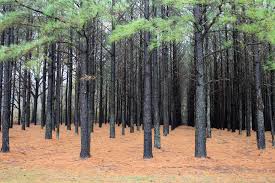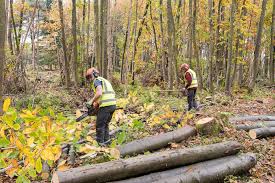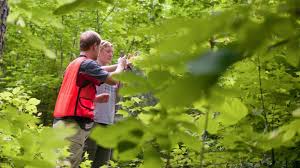Forest resources, vital for humans and other living organisms, are not inexhaustible. This means there is a need to introduce various approaches for managing forest ecosystems.
Effective forest management will not only sustain the products and services of forests, but will also protect and restore ecosystems through the best forestry practices, while maximizing the use of forest land and its environment for human development. These forestry practices include ecoforestry, agroforestry, forest gardening, and certified forestry.
Read Also: Life Cycle and Morphology of Pteridophytes
Forestry

This is defined as the art, science, and practice of studying and managing forested land, plantations, and associated natural resources such as waters and wasteland, primarily for harvesting timber, but also for conservation and recreational purposes. It is related to silviculture, which involves the growing and tending of forests.
Forestry involves the production (tree planting and maintenance), distribution, and consumption of forest products and services. Activities involved in forestry include tree breeding, reforestation, and deforestation (the conversion of natural forests or plantations to non-forest and non-vegetated lands).
Silviculture
This is defined as the theory and practice of controlling the establishment, composition, and growth of stands of trees for goods such as timber, pulp, energy, fruits, and fodder, as well as benefits like water, wildlife habitat, microclimate improvement, and carbon sequestration.
Silviculture is the art and science of controlling the establishment, growth, composition, health, and quality of forests to meet the diverse needs and values of landowners and society.
Forest Management
Forest management refers to a range of interventions that affect forest ecosystems. These include policies for timber cutting, planting and replanting of various species, creating roads and pathways through forests, and techniques for preventing or controlling outbreaks of fire.
The goal is to ensure sustainable use of forest resources, including timber, wood fuel, and other forest products. Additionally, forest management involves activities like reforestation, weed control, thinning, and prevention and control of diseases and forest fires. Other practices include wildlife conservation and watershed protection.
Ecoforestry
Ecoforestry emphasizes holistic practices aimed at protecting and restoring ecosystems rather than maximizing economic productivity. Practitioners of ecoforestry avoid harmful activities like clearcutting, high grading, and the use of pesticides.
Ecoforestry is seen as a traditional practice in which people tend to a forest area, helping it to grow sustainably over many years. It promotes self-regulating ecosystems with diverse species and habitats in harmony with the landscape, weather, soil, water flows, and wildlife.
Read Also: Morphology, Life Cycle, and Classification of Bryophytes
Plantation Forestry

Plantation forestry involves establishing forests through the planting or sowing of trees primarily for timber production. Plantations are often monocultures or consist of only a few species, unlike natural forests which have greater diversity.
These plantations are usually harvested after 10 to 60 years. Some plantations may include tree species that do not naturally occur in the area, such as hybrids or genetically modified species, which are better suited for industrial purposes like wood or pulp production. Plantations can be classified into industrial, home, and ornamental plantations.
1. Industrial plantations: These are established for the production of large volumes of wood over a short period for commercial use.
2. Home plantations: These produce lumber and firewood for domestic use and sometimes for sale.
3. Ornamental plantations: These are primarily used for environmental protection purposes such as erosion control and windbreaks.
Certified Forestry
Several organizations certify that forest management operations are following best practices for sustainable forestry. The Forest Stewardship Council (FSC) issues global standards for sustainable forestry.
While other organizations such as the Sustainable Forestry Initiative (SFI), Woodmark, and the Rainforest Alliance provide similar certifications. Certification ensures that forests are managed responsibly and helps in marketing certified forest products.
Sustainable Forestry
Sustainable forestry aims to ensure that forest goods and services are produced at levels the forest can sustain without degrading soil, watersheds, or seed sources for future generations.
The concept of sustainable forestry also assumes that human use will not detract from the forest’s capacity to support other organisms, emphasizing the importance of healthy ecosystems. Sustainable forestry seeks to balance forest use for human benefits with the need to maintain healthy ecosystems.
Woodland Management

Woodland management focuses on managing woodlands either to maximize timber production or to conserve wildlife. A well-managed woodland can produce a steady supply of timber while maintaining a variety of environments for woodland species such as birds, insects, and flowers. Woodland management techniques include coppicing, pollarding, and shredding.
Agroforestry
Agroforestry is a land use system that involves the deliberate introduction or retention of trees or other plants into crop and livestock production systems. The goal is to increase profitability, environmental protection, and social acceptance.
Agroforestry combines forest trees with crops or domestic animals, aiming to increase crop yields while managing grazing land. Agroforestry systems are classified based on components associated with woody perennials, spatial and temporal distribution of components, productivity and sustainability, and socio-economic criteria.
Forest Farming
Forest farming involves cultivating high-value specialty crops under the protection of a forest canopy. This is an agroforestry practice focused on balancing conservation and the limited utilization of forest resources.
Forest farming management aims to restore ecological balance in secondary growth forests while producing crops like mushrooms, nuts, and medicinal plants. It offers economic benefits such as the sale of specialty crops and modification of ecosystems without disruption.
Forest Gardening
Forest gardening, also known as 3-Dimensional Gardening, is a food production and land management system that mimics natural woodland ecosystems. Trees, bushes, shrubs, herbs, and vegetables are planted together to replicate forest layers, providing yields like fruits, nuts, edible leaves, spices, and medicinal plant products.
Forest gardening is based on companion planting and is used in both tropical and temperate regions. The benefits of forest gardening include creating a long-term biologically sustainable system with minimal maintenance once established.
Sericulture
Sericulture is the rearing of silkworms for the production of raw silk. The most widely used species for commercial silk production is Bombyx mori. Silk is produced by feeding silkworm larvae on mulberry leaves, after which the larvae spin silken cocoons.
The silk filaments are extracted by boiling the cocoons and reeling the silk, which is then used to create yarn. Silkworm rearing and silk production have a long history, with China and Japan leading global production.
Deforestation
Deforestation is defined as the conversion of natural forests or plantations into non-forested and non-vegetated lands. This involves the removal of forest trees without replacement.
Causes of deforestation include population growth, government policies, high energy costs, conversion of forestland to agriculture, overgrazing, logging, mining, and urbanization. The effects of deforestation are severe, leading to biodiversity loss, soil erosion, disruptions in the carbon cycle, and global warming.
In this article, the basic principles of forest management have been explained, showcasing the need for proper practices that will maximize the sustainable exploitation of forest resources for human development.
Do you have any questions, suggestions, or contributions? If so, please feel free to use the comment box below to share your thoughts. We also encourage you to kindly share this information with others who might benefit from it. Since we can’t reach everyone at once, we truly appreciate your help in spreading the word. Thank you so much for your support and for sharing!

